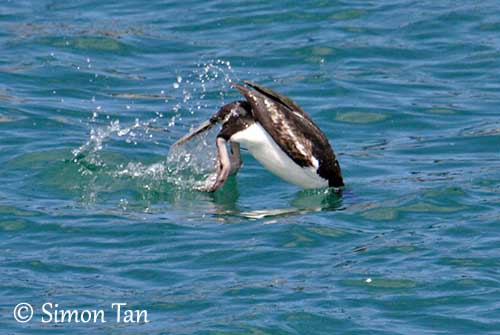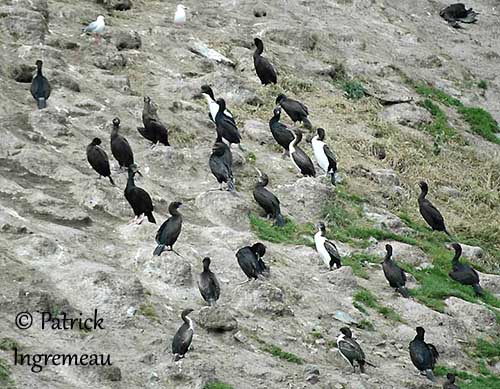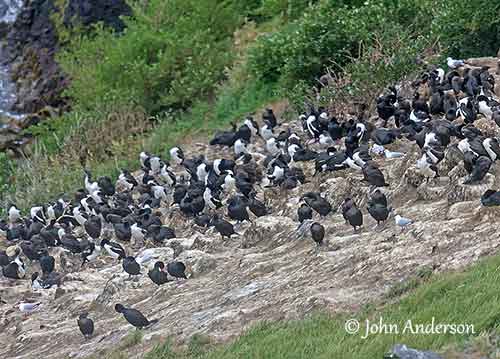
Fr: Cormoran bronzé
Maori: Kwau-mapua
Ang: Bronze Shag or Otago Shag
All: Stewartscharbe
Esp: Cormorán de la Stewart
Ita: Cormorano di Stewart
Nd: Stewartaalscholver
Sd: Stewartskarv
Photographers:
John Anderson
John Anderson Photo Galleries
Patrick Ingremeau
TAMANDUA
Simon Tan
PBase Bird galleries
Text by Nicole Bouglouan
Sources:
HANDBOOK OF THE BIRDS OF THE WORLD vol 1 by Josep del Hoyo-Andrew Elliot-Jordi Sargatal - Lynx Edicions - ISBN: 8487334105
BirdLife International (BirdLife International)
New Zealand bird status between 2008 and 2012
New Zealand birds and birding (Narena Olliver)
Te Ara – The Encyclopedia of New Zealand
Wikipedia, the free encyclopaedia
Page family Phalacrocoracidae
Summary cards
Bronze Shag or Otago Shag
Leucocarbo chalconotus
Suliformes Order – Phalacrocoracidae Family
INTRODUCTION:
The Bronze Shag is endemic to the south-eastern parts of the South Island, New Zealand.
This species has two morphs which regularly breed together. It belongs to the “pink-footed” shag’s group. They typically fly in long lines close to the water while heading to and from their feeding areas.
It is often considered a race of Leucocarbo carunculatus.
DESCRIPTION OF THE BIRD:
Biometrics:
Length: 65-71 cm
Weight: 2500 g
This species has two morphs, pied and dark “bronze”.
The adult of pied morph has black-and-white plumage with dark head and upperparts. There is a blue sheen on the black back. We can see conspicuous white patches on the upperwing, forming a large, white bar on folded wing. The tail is black.
The underparts are white from chin to vent, except the black outer part of the thighs.
The dark “bronze” morph has brownish-black plumage overall, with blue sheen on body and green sheen on wings.
Both morphs have pale brown to greyish bill with dark culmen. The eyes are dark brown, surrounded by blue eyering. Legs and feet are pale pink.
In breeding plumage, both morphs show an erectile black crest on crown, and sometimes some hair-like white filoplumes. They have small orange caruncles at base of upper mandible and purple facial skin.
The non-breeding birds have duller facial pattern and lack crest and filoplumes.
Both sexes are similar.
The juvenile has also two morphs. They are duller overall with pale facial skin and no caruncles. Their plumage is browner with little or no gloss.
RANGE:
The Bronze Shag is found in SE South Island, New Zealand. It can be seen at Otago Harbour, as far north as Oamuru, and as far south as the Catlins. The shags of Stewart Island are smaller than those from Otago.
HABITAT:
The Bronze Shag breeds and roosts on rocky cliffs and headlands, usually on small islands near the shore. It may also use man-made structures.
They forage in coastal waters, bays and harbours. They can forage up to 10-15 kilometres off the Otago coast.

CALLS AND SONGS: SOUNDS BY XENO-CANTO
The Bronze Shag male utters a “borr” call to attract a female. At breeding colonies, when the male returns to the nest, it gives soft “eh-eh-eh” but the female remains silent. The chicks give squeaky “ah-whee-ah” while begging for food.
BEHAVIOUR IN THE WILD:
The Bronze Shag feeds primarily on fish, mainly seabed-dwelling fish, but it also takes crustaceans, crabs and shrimps, and marine worms.
These shags usually forage in small groups and dive at depths of about 30 metres. They can forage in murky water in harbours, and use the “disturb and strike” strategy rather than ‘see and chase”! But they also use the typical pursuit-diving technique outside harbours. They feed on fish mainly in spring, whereas invertebrates and crustaceans are taken in winter. However, foraging in murky water in harbours may be an important threat for the shags, with set-net entanglement.
The Bronze Shag breeds in small or large monospecific colonies of 10 to 500 nests, where the two morphs are present. The nests are very close to each other.
This species can breed all year round. They are probably monogamous.
The nest is reused in successive years, and sometimes becomes sizeable as much as one metre deep.
The shags may desert a colony and establish a new one, but more information is needed for better understanding.

Part of a colonie on steep slope.
The two morphs are together near the nests.
PROTECTION / THREATS / STATUS:
The Bronze Shag is threatened by fishing nets, especially while foraging in harbours. They can be illegally shot by fishers. They are vulnerable to disturbance at colonies.
This species has small range and the number of colonies is decreasing. The population is estimated to number less than 2,500 individuals and suspected to be declining.
In addition, the shags breeding in mainland colonies are threatened by introduced predators such as mustelids, cats and rodents.
The Bronze Shag is considered as Nationally Vulnerable in New Zealand, and is globally classified as Vulnerable.
The Bronze Shag is sedentary. They often fly in small flocks, usually in long lines, and low from the sea surface.
REPRODUCTION OF THIS SPECIES:
The Bronze Shag can breed all year round, depending on local conditions and colonies.
The colonies are established on bare rocks, rocky cliffs and headlands. The nest is a truncated cone made with seaweeds, sticks and grass, cemented together with excreta. The shag often steals materials from unguarded nests. Year after year, they add nest materials and the structure becomes large and high, and can get up to one metre.
The female lays 1-3 eggs, usually between September and November. The incubation is shared by both adults, and lasts between 23 and 35 days.
At hatching, the chicks are naked, but they are quickly covered with grey down. They are fed by regurgitation, usually in the afternoon. They can breed at 3 years old.

Part of a colonie on steep slope.
The two morphs are together near the nests.